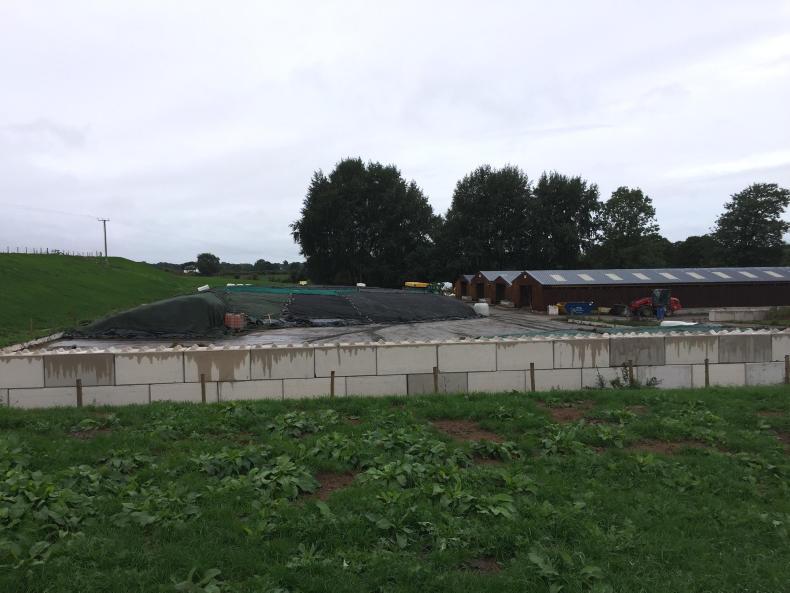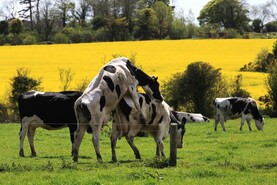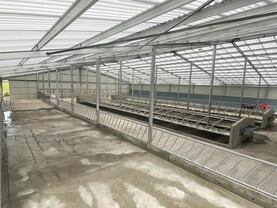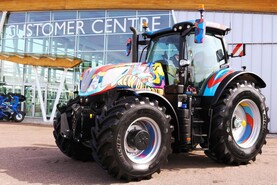The words “autumn calving”, “simple system” and “profitable” are rarely used in the same sentence. But this is exactly what is being achieved at Brookhouse Farm in Stafford, England. The farm is operated on a contract-farming basis between the Carter family, who own the farm and a company called Daylight Farming Ltd. Daylight Farming is 90% owned by the Dale family and 10% owned by Ian Lightfoot. The Dale family are milking about 2,700 cows across five farms in England and Scotland, while Ian is an equity manager in the business – running the farm while having a share in the business.
Dale Farming took on the contract for Brookhouse Farm in 2007 and for 10 years they have run it as a 300-cow spring-calving farm. The farm was operated alongside a 400-cow split-calving farm down the road. But when the lease on that farm came to an end, the system at Brookhouse changed.
Due to the nature of milk processing in the UK, getting a milk contract to run a stand-alone spring-calving farm is very difficult. Milk produced in summer gets a lower price than milk produced in the winter. For this reason, the decision was made to convert Brookhouse from a block spring-calving farm with 300 cows to a block autumn-calving farm with 450 cows. Cows calved in the autumn for the first time in August 2017.
“There are two systems that we copy. The first is the Irish or New Zealand grass-based spring-calving system and the second is the block autumn-calving self-feed silage system adopted by many farmers in southern England as perfected by the consultant Kay Carslaw,” Ed Dale (right)says.
There are 111ha in Brookhouse Farm with a further 121ha of support ground leased in from other landowners in the vicinity. The support ground is used to rear 120 heifers and grow enough winter feed including 28ha of maize. Ed says about one third of the land at Brookhouse is heavy peaty soils, some of which is prone to flooding. The remainder is a mix of free-draining and clay soils. The farm grew 12.6t/ha of grass in 2017. The stocking rate on the platform is high at just over 4 cows/ha but the overall stocking rate is 2.45 cows/ha.

Ed says the cows love the kennels.
Cows calve in an 11 week block starting on 24 August. When the Irish Farmers Journal visited Brookhouse last week, 61% of the 450 cows had calved. Half the cows had calved 13 days after the start of calving. Normally, the cows calve outside on what Ed calls “standing hay”. Due to the drought this summer, the cows are calving on lush green grass. The pre-grazing yield is about 2,000kg/ha and cows are getting a fresh break every day and grazing it down to the base.
At the moment, the farm is sitting at an average farm cover of 550kg/ha. The target is to get to a peak cover of 900kg/ha by early October. Milking cows are back out at grass, grazing covers of about 1,600kg getting an allocation of 10kg grass and 6kg of meal in the parlour. The only cows in the shed now are a few freshly calved cows and a sick mob.

Self-feed silage facility at Brookhouse Farm.
The milkers will be housed full-time in mid-October and at the same time the maiden heifers will come back on to the platform. There are two reasons for this. Ed and Ian want the milkers to be settled on their winter ration for one month prior to the start of the breeding season. The other reason is to have grass for the maiden heifers when breeding starts in mid-November. The maiden heifers are out-wintered on deferred grass. They have a grass demand of 8kg/ha/day while on the platform but go back to the out-farms after mating.
Winter diet
With the move to autumn calving, significant investment was made in the farm yard to make it suitable for housing all the cows. There were 120 cubicles already on the farm, so more housing was required. The decision was made to incorporate the new cubicles into a self-feed silage system. Timber-frame cow kennels were built for 330 cows. The kennels are composed of four double rows of cubicles built in-between the parlour and a new silage slab.
On one side, the passages open out on to the milking parlour side of the yard and on the other side they open out on to silage pit side of the yard. There is a slatted channel between the cubicles and the silage slab making it easier to scrape the yard. This slurry is pumped to a lagoon.
The silage is a mix of maize and grass silage. Two thirds of the feed face will be grass silage, with maize in the rest. Cows can pick and choose themselves whether they want to eat the maize or the grass silage. Just short of 330 cows are fed and wintered in this part of the yard while 120 cows are housed in the old cubicles and fed self-feed grass and maize silage there.
Cows get access to 9in of feed face per cow and the height of the pit is no more than about 7ft high so cows can reach all the silage without the need for a loader. The only jobs to be done to feed 450 cows is to strip back the pit every few days and move the wire daily. The yard and cubicles are scraped twice a day during milking. Cubicles are scraped down and topped up with a mix of lime and sawdust twice daily. Feeding and scraping takes one hour per day.
The cows are milked through a 26-unit parlour, taking 3.5 hours per milking. Two people operate the farm outside of calving and breeding. One person milks while the other scrapes the yards. A cab-less John Deere 5055 does most of the scraping. Ed says that cows love the timber kennels. They cost £450/cow space (€504/cow space) excluding slurry storage and the silage slab.
Cows go back out to grass in mid-February. During the winter, they are on a self-feed silage and 7kg of 27% protein meal through the parlour. Last year, the herd of New Zealand Friesian and Jersey crossbred cows produced 559kg of milk solids per cow from 1.8t of meal per cow.
Ian oversees the management of the farm, with two full-time employees, a relief milker and a student. Last year, the farm made a net profit of £675/cow (€757/cow). This is before debt repayments, taxation and BPS, but includes all labour.
The farm gets about 30in of rain per year (760mm), which is a help in making the self-feed silage system work.
The words “autumn calving”, “simple system” and “profitable” are rarely used in the same sentence. But this is exactly what is being achieved at Brookhouse Farm in Stafford, England. The farm is operated on a contract-farming basis between the Carter family, who own the farm and a company called Daylight Farming Ltd. Daylight Farming is 90% owned by the Dale family and 10% owned by Ian Lightfoot. The Dale family are milking about 2,700 cows across five farms in England and Scotland, while Ian is an equity manager in the business – running the farm while having a share in the business.
Dale Farming took on the contract for Brookhouse Farm in 2007 and for 10 years they have run it as a 300-cow spring-calving farm. The farm was operated alongside a 400-cow split-calving farm down the road. But when the lease on that farm came to an end, the system at Brookhouse changed.
Due to the nature of milk processing in the UK, getting a milk contract to run a stand-alone spring-calving farm is very difficult. Milk produced in summer gets a lower price than milk produced in the winter. For this reason, the decision was made to convert Brookhouse from a block spring-calving farm with 300 cows to a block autumn-calving farm with 450 cows. Cows calved in the autumn for the first time in August 2017.
“There are two systems that we copy. The first is the Irish or New Zealand grass-based spring-calving system and the second is the block autumn-calving self-feed silage system adopted by many farmers in southern England as perfected by the consultant Kay Carslaw,” Ed Dale (right)says.
There are 111ha in Brookhouse Farm with a further 121ha of support ground leased in from other landowners in the vicinity. The support ground is used to rear 120 heifers and grow enough winter feed including 28ha of maize. Ed says about one third of the land at Brookhouse is heavy peaty soils, some of which is prone to flooding. The remainder is a mix of free-draining and clay soils. The farm grew 12.6t/ha of grass in 2017. The stocking rate on the platform is high at just over 4 cows/ha but the overall stocking rate is 2.45 cows/ha.

Ed says the cows love the kennels.
Cows calve in an 11 week block starting on 24 August. When the Irish Farmers Journal visited Brookhouse last week, 61% of the 450 cows had calved. Half the cows had calved 13 days after the start of calving. Normally, the cows calve outside on what Ed calls “standing hay”. Due to the drought this summer, the cows are calving on lush green grass. The pre-grazing yield is about 2,000kg/ha and cows are getting a fresh break every day and grazing it down to the base.
At the moment, the farm is sitting at an average farm cover of 550kg/ha. The target is to get to a peak cover of 900kg/ha by early October. Milking cows are back out at grass, grazing covers of about 1,600kg getting an allocation of 10kg grass and 6kg of meal in the parlour. The only cows in the shed now are a few freshly calved cows and a sick mob.

Self-feed silage facility at Brookhouse Farm.
The milkers will be housed full-time in mid-October and at the same time the maiden heifers will come back on to the platform. There are two reasons for this. Ed and Ian want the milkers to be settled on their winter ration for one month prior to the start of the breeding season. The other reason is to have grass for the maiden heifers when breeding starts in mid-November. The maiden heifers are out-wintered on deferred grass. They have a grass demand of 8kg/ha/day while on the platform but go back to the out-farms after mating.
Winter diet
With the move to autumn calving, significant investment was made in the farm yard to make it suitable for housing all the cows. There were 120 cubicles already on the farm, so more housing was required. The decision was made to incorporate the new cubicles into a self-feed silage system. Timber-frame cow kennels were built for 330 cows. The kennels are composed of four double rows of cubicles built in-between the parlour and a new silage slab.
On one side, the passages open out on to the milking parlour side of the yard and on the other side they open out on to silage pit side of the yard. There is a slatted channel between the cubicles and the silage slab making it easier to scrape the yard. This slurry is pumped to a lagoon.
The silage is a mix of maize and grass silage. Two thirds of the feed face will be grass silage, with maize in the rest. Cows can pick and choose themselves whether they want to eat the maize or the grass silage. Just short of 330 cows are fed and wintered in this part of the yard while 120 cows are housed in the old cubicles and fed self-feed grass and maize silage there.
Cows get access to 9in of feed face per cow and the height of the pit is no more than about 7ft high so cows can reach all the silage without the need for a loader. The only jobs to be done to feed 450 cows is to strip back the pit every few days and move the wire daily. The yard and cubicles are scraped twice a day during milking. Cubicles are scraped down and topped up with a mix of lime and sawdust twice daily. Feeding and scraping takes one hour per day.
The cows are milked through a 26-unit parlour, taking 3.5 hours per milking. Two people operate the farm outside of calving and breeding. One person milks while the other scrapes the yards. A cab-less John Deere 5055 does most of the scraping. Ed says that cows love the timber kennels. They cost £450/cow space (€504/cow space) excluding slurry storage and the silage slab.
Cows go back out to grass in mid-February. During the winter, they are on a self-feed silage and 7kg of 27% protein meal through the parlour. Last year, the herd of New Zealand Friesian and Jersey crossbred cows produced 559kg of milk solids per cow from 1.8t of meal per cow.
Ian oversees the management of the farm, with two full-time employees, a relief milker and a student. Last year, the farm made a net profit of £675/cow (€757/cow). This is before debt repayments, taxation and BPS, but includes all labour.
The farm gets about 30in of rain per year (760mm), which is a help in making the self-feed silage system work.









 This is a subscriber-only article
This is a subscriber-only article










SHARING OPTIONS: